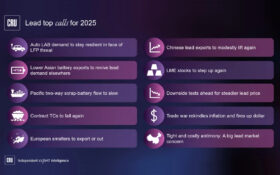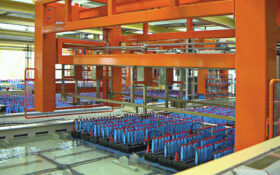Mineral exploration company Spearmint Resources said it acquired the George Lake South Antimony Project in New Brunswick, Canada, amid a price boom for the mineral. The mining project consists of 1,945 contiguous acres prospective for antimony.
James Nelson, president of Spearmint, said : “Year to date, antimony prices have more than doubled, making it one of the best performing commodities this year. This is a great addition to our stable of projects and being in Canada, it allows us to access flow through money if needed.”
The company said the new project is in the direct vicinity of the Lake George Antimony Mine in New Brunswick. It was operated intermittently from 1876 – 1996 and was once the largest primary antimony producer in North America.
Antimony is used in lead-acid batteries and in emerging technologies such as energy storage and lithium-ion battery enhancements. It is also used in ammunition, solar panels and flame-retardant materials. Spearmint said as safety regulations around fire-resistant materials become stricter, the need for antimony-based compounds continues to grow.
Pricing agency Fastmarkets reported on 18 November that United States Antimony Corporation has been holding financing discussions with the US Department of Defense (DoD) to significantly expand the capacity of the country’s only antimony smelter.
The plant, in Montana, is running at 50% nominal capacity at around 160 tonnes/month, it said. It has the ability to double production and plans to quadruple it, according to company chairman Gary Evans. The report quoted Evans saying the company started receiving calls from the DoD following China’s restrictions.
In August, we reported China planned to introduce restrictions on antimony exports and this could lead to another flashpoint with the West over control of critical minerals.
Evans told Fastmarkets China began buying up antimony mines around the world 10 – 15 years ago, providing effective control of the market. “At around the same time, the Environmental Protection Agency in the United States was shutting down antimony mines because of its concern over arsenic and other contaminants with regards to pollution. And therefore, as we sit here today, there are currently no active antimony mines in the United States.”
Fastmarkets’ twice-weekly price assessment for antimony, MMTA standard grade II, in-whs Rotterdam was $37,500 – 38,500 per tonne on 29 November, up from $10,900 – 11,500 per tonne a year earlier. However, this is currently a big gap (+$15,000) between the China domestic price and rest of the world. Antimony prices in China have been dropping since the announcement of export controls, while global prices have been constantly increasing. Its price reporter, Xiaoying Du, told BEST data from USGS shows the total global antimony mine production in 2023 was approximately 83,000 tonnes.












